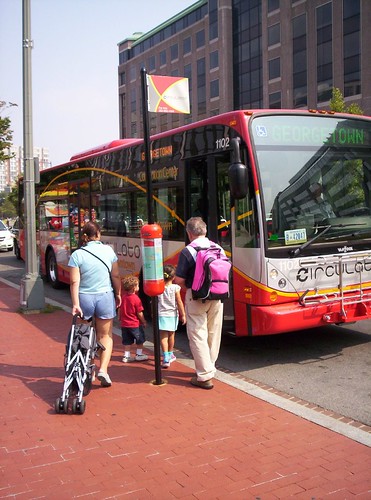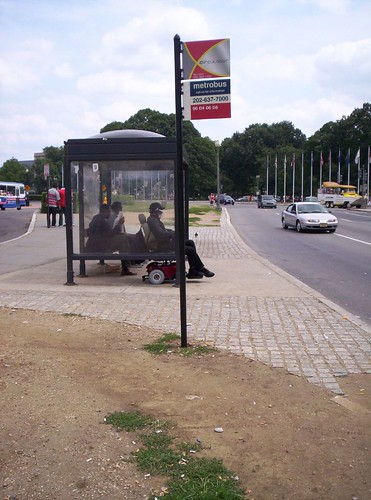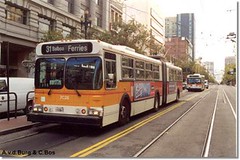Metrobus Capital Improvement Program
 Downtown Circulator bus, manufactured by Van Hool.
Downtown Circulator bus, manufactured by Van Hool.Today's newspapers, including the Washington Post in "$830 Million Set Aside for Metrobuses," report on WMATA's Metrobus Capital Improvement Program. The status report distributed at the WMATA Board of Directors meeting is online here. (Also see the previous blog entry from June, "Metrobus Peer review Report".)
 Bus stop at 4th and H Streets, NE, Washington, DC.
Bus stop at 4th and H Streets, NE, Washington, DC.This is an important program. The bus fleet and system needs to be upgraded, or at the very least treated with respect. It is an unfortunate fact that in the minds of consumers, the bus system will always play second fiddle to the subway system. But for many, it is the most convenient and/or efficient way to get around. Threadbare bus shelters and too often a lack of information about using the bus system at the "point of purchase" are poor ways to "market" the bus system. And it certainly discourages people from trying it out.
How many times have you heard a line from someone that goes something like this: "Buses are only for people who can't afford cars?" If more people used the system, it's better for everyone in terms of revenue and in terms of reducing street congestion by taking more cars of the streets in the region. It also builds more political support for transit.
 New and Old at Union Station.
New and Old at Union Station.The Downtown Circulator bus system offers a different paradigm. The buses are attractive, comfortable inside (and this isn't just because the buses are new), and compared to the average Metrobus much quieter, with attractive signage and direction information at bus stops.
 Typical Downtown Circulator bus stop.
Typical Downtown Circulator bus stop. Bus stop at Union Station.
Bus stop at Union Station.I hope that WMATA will think further about this, and consider Van Hool buses for some of the city routes. Comfort and attractiveness are key to ridership and sastisfaction.
I think that the noise issue is particularly important. On streets with high frequency bus service--streets such as H Street, 8th Street, Florida Avenue, etc.--the traditional Metrobuses are so loud that it militates against sitting on your front porch and hanging out with your neighbors. Places with a great concentration of bus stops, such as 8th and H Street NE are cacaphonous.
As a friend of mine pointed out about the electrified bus system in San Francisco, those buses are quiet and it makes a huge difference in terms of being able to enjoy being out and about in the city.
 Electric bus in San Francisco. Image from www.busexplorer.com
Electric bus in San Francisco. Image from www.busexplorer.com 


0 Comments:
Post a Comment
<< Home